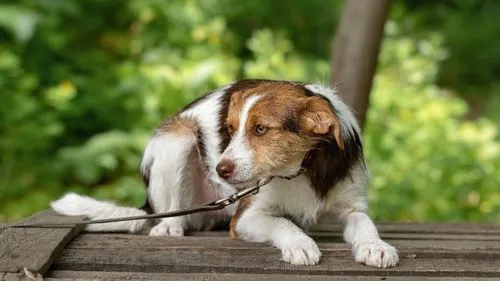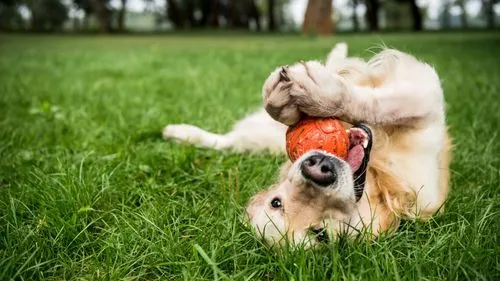How to cool down a dog: Dog temperature, heat stroke
July 07, 2025
Katka

Dogs are beloved members of our families, and ensuring their well-being is a top priority, especially during hot weather. Understanding how to cool down a dog effectively can prevent serious health issues, such as dog heat stroke. In this article, we will explore the risks associated with high body temperatures in dogs, how dogs naturally cool down, and practical steps to help them stay cool.
Dog body temperature
A dog's normal body temperature ranges between 101°F and 102.5°F (38.3°C to 39.2°C). When their body temperature rises above 103°F (39.4°C), they are at risk of hyperthermia, commonly known as heat stroke. Recognizing the signs and knowing how to cool down a dog is crucial for their health and safety.
How do dogs cool down
Dogs do not sweat like humans. Instead, they rely on panting and external cooling methods to regulate their body temperature.
Panting is the primary mechanism dogs use to cool down. When a dog pants, moisture evaporates from their tongue and respiratory tract, dissipating heat. However, panting alone may not be sufficient in extreme heat or during intense physical activity.
Signs your dog needs help cooling down
Recognizing when your dog is overheating is crucial. Look for symptoms like:
- Excessive panting
- Drooling
- Red or pale gums
- Rapid heartbeat
- Lethargy
- Vomiting or diarrhea
- Staggering or collapsing
If you observe these signs, it’s essential to act quickly to cool your dog down.

How to cool down a dog
If your dog shows signs of overheating, it's good to know how to cool down a dog fast. Take the following steps immediately:
1. Move dog to a cool area
Find a shaded or air-conditioned space.
2. Offer water
Provide small amounts of cool (not cold) water to drink.
3. Use cooling methods
- Cool water bath: Submerge your dog in cool (not cold) water.
- Use wet towels: Apply cool, wet towels to their body, focusing on the neck, armpits, and groin.
- Ice packs: Place ice packs wrapped in a cloth on their chest and back of the neck.
- Fan your dog: Increase air circulation with a fan.
Alert: If your dog continues to exhibit signs of overheating despite your cooling efforts, seek veterinary assistance immediately. Persistent symptoms such as rapid panting, extreme lethargy, and unresponsiveness require professional evaluation and care.

Heat exhaustion and dog heat stroke
Overheating can lead to heat stroke, a life-threatening condition. Some common signs include excessive panting, drooling, weakness, vomiting, and collapse. If a dog’s body temperature exceeds 106°F (41.1°C), it can result in severe damage to their organs and even death.
Awareness and timely intervention can make a significant difference. Always pay attention to your dog’s behavior. When you have to leave your dog home alone and you know that it is going to be hot in there, you can use some of our ideas on how to cool the dog down and check on it using our Barkio dog monitor app.
Preventing heat stroke in dogs
Preventive measures are the best way to protect your dog from heat stroke.
Regular health check-ups: Regular veterinary check-ups can help identify any underlying health issues that may increase the risk of heat stroke.
Proper diet: Maintain a balanced diet to ensure your dog is in optimal health, as overweight dogs are more prone to overheating.
Education and awareness: Educate yourself and others about the signs of heat stroke and the importance of keeping dogs cool.
On top of that, you can prevent heatstroke by ensuring:
Water
Always ensure your dog has access to fresh, cool water. Hydration is key to preventing heat-related issues.
The best water temperature for dogs to drink is cool but not ice-cold. Water around 50°F to 60°F (10°C to 15°C) is ideal. Providing ice-cold water is generally not recommended as it can lead to stomach cramps or shock if a dog drinks it too quickly. Instead, offer cool, fresh water.
Dog pools
Setting up a dog pool can be a fantastic way to help your dog cool off. Ensure the pool is in a shaded area and that the water is refreshed regularly to keep it clean and cool. Always supervise your dog while they are in the pool to ensure safety.
Create a cool environment
Set up a cool area with shade and ventilation. Use fans or air conditioning to maintain a comfortable temperature.
You can also use cooling products like cooling pads, vests, and collars. These products are designed to help dissipate heat effectively.
Avoid peak heat hours
Limit outdoor activities during the hottest parts of the day, typically between 10 AM and 4 PM. Opt for early morning or late evening walks instead.
Grooming
Regular grooming can help prevent overheating. Keep your dog’s coat well-trimmed, but avoid shaving it completely, as their fur also provides insulation against heat.
Ice cream for dogs
Regular ice cream is not suitable for dogs due to its sugar and lactose content. However, you can make dog-friendly ice cream using plain yogurt and dog-safe ingredients like peanut butter or pureed fruit. Freeze the mixture in small portions for a cool treat.
Dog heat stroke temperature chart
Knowing the critical temperature thresholds can help in monitoring your dog’s condition.

Source: https://www.petplan.com.au/blog/dogs/how-hot-is-too-hot/
FAQs
How can I cool my dog down during a heatwave?
During a heatwave, keep your dog indoors in an air-conditioned room, provide plenty of water, and use cooling mats or wet towels to help regulate their body temperature.
Can ice water cause problems for my dog?
Ice water can cause stomach cramps and shock if ingested too quickly. It’s better to offer cool, not cold, water.
Is it safe to shave my dog’s fur to keep them cool?
Shaving a dog’s fur can remove their natural protection against the sun and heat. Instead, trim their coat and ensure they are groomed regularly.
What should I do if my dog died from heat stroke?
If your dog died from heat stroke, it’s important to inform your vet and learn from the experience to prevent future incidents. Share your knowledge with other pet owners to raise awareness.
How do I use a dog heat stroke chart?
A dog heat stroke chart helps you monitor and identify critical temperature levels. Regularly check your dog’s temperature during hot days and use the chart to determine the necessary actions.
Can all dogs get heat stroke, or are some breeds more susceptible?
All dogs can get heat stroke, but brachycephalic breeds (like Bulldogs and Pugs), older dogs, and overweight dogs are at higher risk. Take extra precautions with these breeds.
What are some effective ways to keep a dog cool in summer?
Effective ways include providing ample water, creating a cool environment, using cooling products, avoiding peak heat hours, and ensuring regular grooming.
How to cool down a dog that’s been exercising?
After exercise, offer your dog water, use a damp towel to cool them down, and ensure they rest in a shaded area.
Why is my dog panting heavily even indoors?
Heavy panting indoors could indicate overheating, stress, or a health issue. Ensure they are in a cool environment and consult your vet if panting persists.
Is it safe to give dogs ice or ice water?
Giving dogs ice cubes to chew can be a fun and effective way to cool them down, but it should be done with caution. Ice cubes can be a choking hazard, so ensure they are of an appropriate size for your dog. Always supervise them while they chew on ice.
Conclusion
By understanding the risks of heat stroke and implementing preventive measures, you can ensure your dog stays safe and cool during the hot summer months. remember that the best way to cool down a dog involves a combination of methods: hydration, cool environment, cooling products and monitoring dog activity.
Continue reading...
Show all articlesCopyright & trademark notices
Apple, the Apple logo, and iPhone are trademarks of Apple Inc., registered in the U.S. and other countries and regions. App Store is a service mark of Apple Inc. Mac App Store is a service mark of Apple Inc. Google Play and the Google Play logo are trademarks of Google LLC. Windows® and the Windows logo are either registered trademarks or trademarks of Microsoft Corporation in the United States and/or other countries. Linux® is the registered trademark of Linus Torvalds in the U.S. and other countries.


